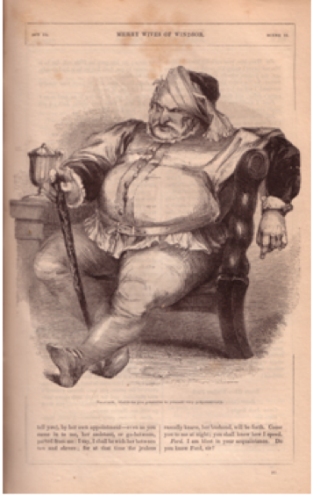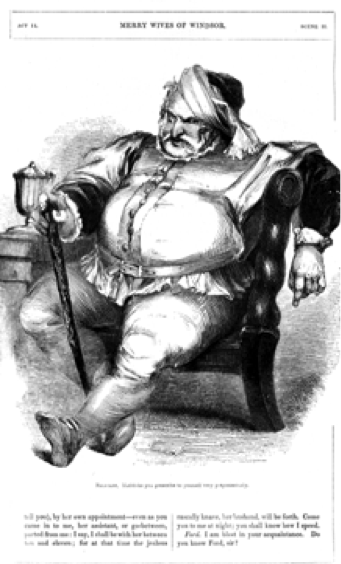‘As an historian I find what you are doing horrifying’. This remark, directed at the paper I just gave at the Sheffield Digital Humanities Congress in 2012, is, on the face of it, not particularly encouraging. My paper, entitled ‘Art to Enchant: The Creation of a Digital Archive’ explored in detail my process and methodology in the creation of the Victorian Illustrated Shakespeare Archive (VISA). What particularly angered this member of the audience was my in-depth demonstration of the procedures I use to ‘clean up’ the images that make up the archive and my subsequent assertion that when we digitise an historical artefact it becomes translated – adapted – into a different medium, thus creating an entirely new and original artefact. The audience member took great exception to this because it called into question his deeply held belief that we can know history as an objective fact; that the books, documents, and images we find in libraries and archives are transparent texts, that they reveal to us truths and give us direct access to their own historical eras.
Implicit within his argument is one which also calls into question his very own occupation as an historian: if the public can access the historical record, like they can with VISA (in previous decades this idea of access and who has access to what would have only been granted to members of ‘The Academy’), then you are also bestowing on the public a power to interpret that historical record. It is this concept of interpretation and who is allowed to interpret (and what they are allowed to interpret), which is the cause of much unease within academia surrounding the Digital Humanities. For over thirty years now, as Terence Hawkes has noted, we have been living in an intellectual environment dominated by Stephen Greenblatt’s famous aphorism ‘I began with a desire to speak to the dead’. It is about time, given the current state of academic publishing and the public perception of the humanities, that we started to speak to the living.
The writer, I suggest, who has been fundamental in theorizing this desire to speak with the living is Jay David Bolter. In Writing Space, and later, with Richard Grusin, in Remediation, Bolter discusses the process through which new media, in an attempt to gain cultural significance and thus credibility, refashion older forms of media. I have argued, elsewhere , that this is exactly what the Victorians did with wood engraving and Shakespeare: by taking a new technology, such as wood engraving, and applying it to a culturally significant text, in this case The Complete Works of Shakespeare. Through this process of remediation wood engraving is then seen to have gained a certain amount of cultural capital that in turn makes it a socially acceptable new technology. Bolter and Grusin use broader examples than this, for example, they discuss how film remediates the theatre and photography, how photography remediated painting, and how television remediated the theatre and radio. What is so interesting, however, especially for our purposes here, is the crucial role Shakespeare has played in all these processes of remediation. Since the invention of photography back in the 1840s photographers have sought to capture Shakespeare performances on stage, one of the earliest ever films is Herbert Beerbohlm Tree’s King John, and when the BBC first started broadcasting in 1936, Shakespeare, according to the British Film Institute was ‘often on the menu, to give the new medium a veneer of respectability.’ Shakespeare, it seems, is always at the forefront of remediation, and, perhaps, ironically, speaking to the living.

For Bolter and Grusin the process of remediation exists in two forms that they describe as a ‘double-logic’. They argue, convincingly, that remediation is a defining characteristic of new media and that when new media refashions older media it does so with either the ‘logic’ of transparent immediacy or hypermediacy. Transparent immediacy is the ‘logic’ or strategy that the audience member at the Sheffield conference wanted to see displayed in the demonstration of my archive. It is the very human desire to see objects of representation as unmediated and for the viewer to feel as if they are in the presence of those objects themselves. Media that exemplify this strategy include perspective painting, photography and mainstream film. What these media all have in common is their claim to represent the ‘real’ and thus to offer the viewer a more ‘authentic’ unmediated experience. For example, a painting using linear perspective very rarely, if ever, calls attention to the canvas it is painted on, or its frame, as to do so would make us aware that what we are looking at is simply a representation. VISA was too obviously mediated for the historian in the audience; the illustrations and the design of the archive, as we will see later, had become too heavily treated to be of any interest to him. The historian ideally wanted, as Bolter and Grusin write, ‘The digital medium […] to erase itself, so that the viewer stands in the same relationship to the content as she would if confronting the original medium.’ This encounter with the original medium would then, presumably, offer the historian an acceptable position from which he could pass ‘objective’ judgement on the content.
Yet this erasure and encounter is surely impossible because, whether we like it or not, digital media is hypermediated. This second of the two ‘logics’ of remediation privileges ‘images, sound, text, animation and video, which can be brought together in any combination. It is a medium that offers “random access”; it has no physical beginning, middle, or end’. Moreover:
hypermediacy acknowledges multiple acts of representation and makes them visible. Where immediacy suggests a unified visual space, contemporary hypermediacy offers a heterogeneous space, in which representation is conceived of not as a window on to the world, but rather as “windowed” itself – with windows that open on to other representations or other media.
The hypermediated style, however, is not just a digital phenomenon.

Whilst its most obvious manifestation is the World Wide Web itself, hypermediacy can be seen throughout history: the twentieth-century artistic movements such as Cubism, Dada, Pop Art and Collage, for example, all embrace viewpoints and strategies that are multiple. As opposed to representing the world as a unified whole these movements are more concerned with, and meditate upon, their own modes of representation themselves. They make us aware that what we are looking at is a construction. Richard Lanham, in his book The Electronic Word: Democracy, Technology, and the Arts, has even described collage as ‘the central technique of twentieth-century visual art’. If this is so, then it should not be a surprise that fundamental to the success of the desktop computer has been the ability to ‘cut’ and ‘paste’ words and images and to place them in new contexts and recombine them in new ways. In effect, the capacity for computers to take information, whether that is words, images, sounds or video, and to store that information in random access memory, ready for retrieval at any moment and in any context, means that anyone who has ever used a computer is an effective collagist. The world appears to us as fragments of texts and images, because, in a very real practical way, we make it so. A computer remediates.
However, like the interplay we see between word and image in relation to illustration, what makes remediation a fascinating critical practice is that these two logics – transparency and hypermediacy – are in a symbiotic relationship with each other: ‘new digital media oscillate between immediacy and hypermediacy, between transparency and opacity’, observe Bolter and Grusin. Viewing a digital image on screen is a very different experience from viewing that image in an art gallery or on the page, but just because a historical digitised object exists in a hypermediated space does not mean that that object bears no relation to the original object. It is this tension between original and copy, between the past and the present, between transparent and hypermediated spaces which is the cause of so much anxiety concerning digital archival work. But it is precisely because this work creates these anxieties and challenges deeply held cultural assumptions that make this work so worthwhile.
Given the clarity and articulateness with which Bolter and Grusin argue their case for remediation as a concept, it is surprising how often critics and practitioners have misinterpreted what they are saying. I paraphrase here, but the Victorian scholar Kathryn Sutherland, at a conference in Durham in 2012, went as far as saying ‘for the past ten years all I have heard is remediation. I am fed up of remediation. Putting things on a computer is not interesting. In many ways the World-Wide-Web has taken away much of what was interesting with electronic literature that was happening back in the 90’s with CD-ROMS.’ Sutherland, like many others, seems to conflate the idea of remediation with simple digitisation. Let us be clear: digitisation, in and of itself, without a theoretical underpinning, has no purpose here, either in this discussion or a role within academia more generally. Sutherland is right (if we take the view that remediation is digitisation): digitisation is inherently uninteresting. Simply placing things on the web with no underlying structure, thought, design or meta-data does not make for an intellectually rewarding experience either as a user or practitioner.
Bolter and Grusin’s main point, however, and it is one explored further in Bolter’s essay, ‘Critical Theory and The Challenge of New Media’, is that we embrace the potential of the digital medium whilst being aware. Instead of thinking about the Web as a simulacrum for various kinds of historical texts and documents, we instead begin to think of the Web as an environment in which these artefacts have undergone, to quote Shakespeare, ‘a sea-change/Into something rich and strange.’ In short, instead of trying to create an environment where the digitised artefacts are trying to be transparent reflections of their ‘real-world’ counterparts, we instead embrace remediation, a heightened awareness of the medium itself and the advantages that that medium can bestow upon these texts. Institutionally, within universities, and museums and within work done in the Digital Humanities itself, we are still conceptualising our digital work in relation to print. There is an institutional reluctance, I suggest, prompted by the long dark shadow of print technology, to fully explore hypermediacy and digital experimentation; the implications and potential of digital artefacts and technology, and the positive contribution the Web can make intellectually and socially in helping us better understand them. It is this reluctance to explore the full potential of the digital that Kathryn Sutherland finds so frustrating. This reluctance and frustration – which I share with Sutherland – is one I have sought to rectify in the creation of the Victorian Illustrated Shakespeare Archive and it is this rectification, or intervention, that VISA makes into the Print/Digital debate that so ‘horrified’ the delegate at the Sheffield conference.
The Victorian Illustrated Shakespeare Archive will be available shortly at Shakespeareillustration.org
Remediation by Jay David Bolter and Richard Grusin is published by MIT Press
Michael Goodman
goodmanmj@cardiff.ac.uk
